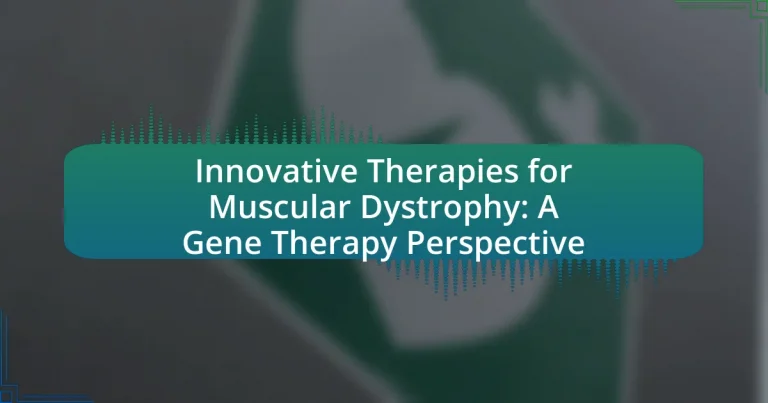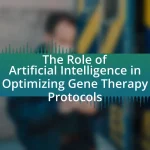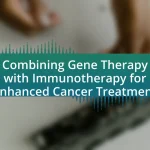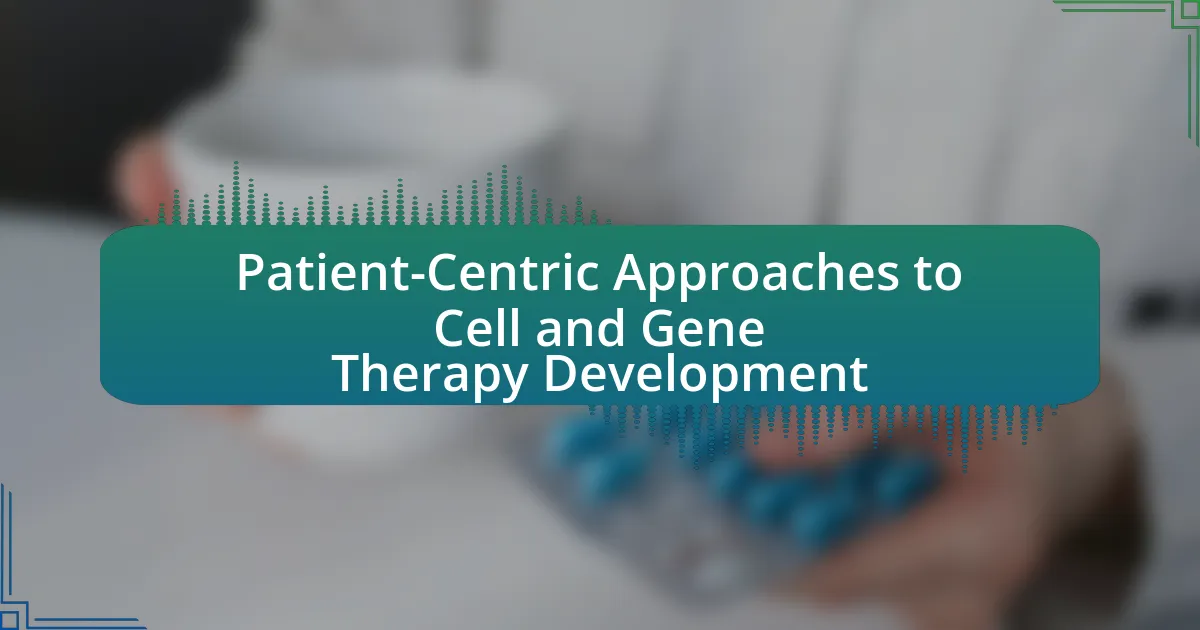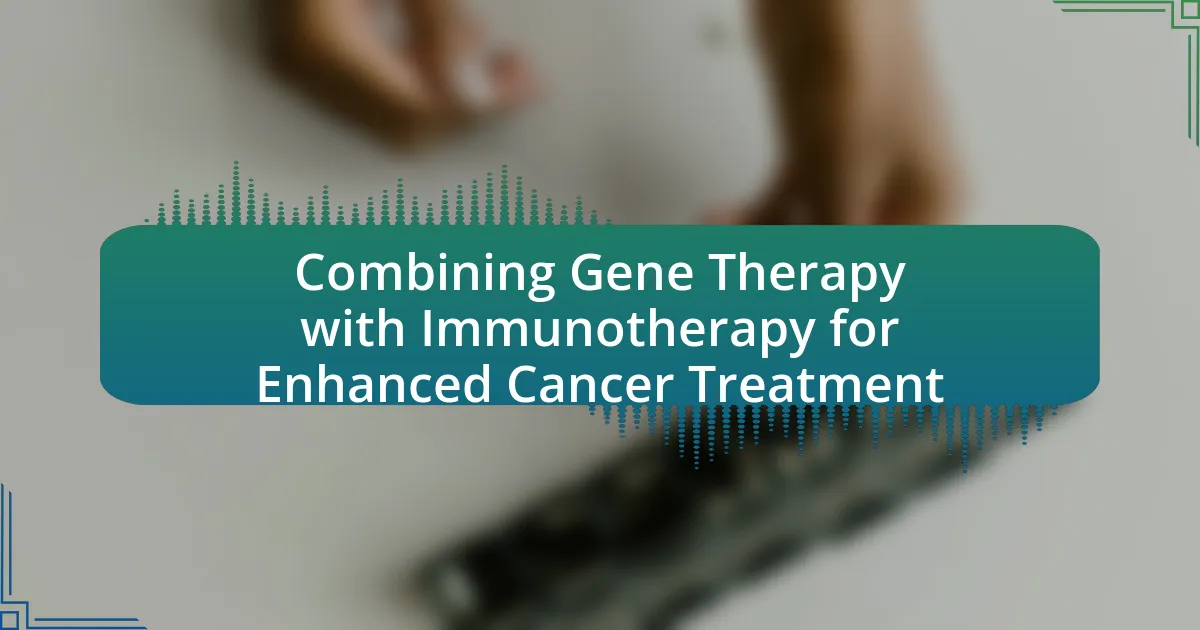Innovative therapies for muscular dystrophy focus on gene therapy approaches that aim to correct genetic defects responsible for the disease. Key methods include the use of adeno-associated virus (AAV) vectors for gene delivery and CRISPR-Cas9 technology for gene editing, both of which have shown promise in clinical trials. These therapies differ from traditional treatments by targeting the root causes of muscular dystrophy rather than merely managing symptoms. The article discusses the limitations of conventional therapies, the potential benefits of gene therapy, ongoing research advancements, and the challenges faced in implementing these innovative treatments.

What are Innovative Therapies for Muscular Dystrophy?
Innovative therapies for muscular dystrophy primarily include gene therapy approaches aimed at correcting or compensating for genetic defects. One prominent example is the use of adeno-associated virus (AAV) vectors to deliver therapeutic genes directly to muscle cells, which has shown promise in clinical trials. For instance, the drug Exondys 51, developed by Sarepta Therapeutics, utilizes exon skipping to bypass defective parts of the dystrophin gene, demonstrating efficacy in improving muscle function in patients with Duchenne muscular dystrophy. Additionally, CRISPR-Cas9 technology is being explored to edit genes at the DNA level, potentially offering a permanent solution to genetic mutations causing muscular dystrophy. These therapies are supported by ongoing research and clinical trials that validate their effectiveness and safety in treating this group of disorders.
How do these therapies differ from traditional treatments?
Innovative therapies for muscular dystrophy, particularly gene therapies, differ from traditional treatments by targeting the underlying genetic causes of the disease rather than merely alleviating symptoms. Traditional treatments often focus on physical therapy, corticosteroids, and supportive care, which do not address the root genetic mutations responsible for muscular dystrophy. In contrast, gene therapies aim to correct or replace defective genes, potentially leading to more effective and long-lasting solutions. For instance, the FDA-approved gene therapy for spinal muscular atrophy, Zolgensma, demonstrates the efficacy of directly addressing genetic defects, resulting in significant improvements in motor function compared to conventional approaches.
What are the limitations of traditional treatments for muscular dystrophy?
Traditional treatments for muscular dystrophy primarily include physical therapy, corticosteroids, and assistive devices, but they have significant limitations. These treatments do not halt disease progression or address the underlying genetic causes of muscular dystrophy, leading to continued muscle degeneration and loss of function. For instance, corticosteroids can help improve muscle strength and function temporarily but are associated with side effects such as weight gain and osteoporosis. Additionally, physical therapy can enhance mobility but cannot reverse muscle damage. Consequently, these traditional approaches focus on managing symptoms rather than providing a cure, highlighting the need for innovative therapies like gene therapy that target the root causes of the disease.
How do innovative therapies address these limitations?
Innovative therapies address limitations in muscular dystrophy by utilizing gene therapy techniques that target the underlying genetic causes of the disease. These therapies, such as CRISPR-Cas9 and adeno-associated virus (AAV) vectors, enable precise editing or replacement of defective genes, thereby restoring normal protein function. For instance, clinical trials have demonstrated that AAV-mediated gene delivery can effectively increase dystrophin levels in patients with Duchenne muscular dystrophy, leading to improved muscle function and reduced disease progression. This approach directly tackles the limitations of traditional treatments, which often focus on symptom management rather than addressing the root genetic issues.
What role does gene therapy play in these innovative therapies?
Gene therapy plays a crucial role in innovative therapies for muscular dystrophy by directly addressing the genetic mutations that cause the disease. This approach involves delivering functional copies of genes or utilizing techniques like CRISPR to edit defective genes, thereby restoring normal function in muscle cells. For instance, the FDA-approved gene therapy Zolgensma treats spinal muscular atrophy by replacing the missing SMN1 gene, demonstrating the potential of gene therapy to significantly improve muscle function and patient outcomes.
What is gene therapy and how does it work?
Gene therapy is a medical technique that involves altering the genes inside a patient’s cells to treat or prevent disease. This process typically works by delivering therapeutic genes into a patient’s cells using vectors, often derived from viruses, which can effectively introduce the new genetic material. For instance, in the context of muscular dystrophy, gene therapy aims to replace or repair defective genes responsible for muscle degeneration, thereby restoring normal function. Clinical trials have demonstrated the potential of gene therapy to improve muscle strength and function in patients with specific genetic mutations associated with muscular dystrophy, highlighting its efficacy and transformative potential in treating this condition.
What types of gene therapy are being explored for muscular dystrophy?
Several types of gene therapy are being explored for muscular dystrophy, including exon skipping, gene replacement, and CRISPR/Cas9 gene editing. Exon skipping aims to bypass faulty parts of the dystrophin gene to produce a functional protein, while gene replacement involves delivering a correct copy of the dystrophin gene to muscle cells. CRISPR/Cas9 gene editing is being investigated for its potential to directly correct mutations in the dystrophin gene. These approaches are supported by ongoing clinical trials and research, demonstrating their viability in addressing the underlying genetic causes of muscular dystrophy.
What are the potential benefits of gene therapy for muscular dystrophy patients?
Gene therapy offers significant potential benefits for muscular dystrophy patients, primarily by addressing the underlying genetic defects responsible for the disease. This innovative approach can lead to the restoration of dystrophin production, which is crucial for muscle function, thereby improving muscle strength and function. Clinical trials, such as those involving the use of adeno-associated virus (AAV) vectors, have demonstrated that delivering functional copies of the dystrophin gene can result in measurable improvements in muscle performance and overall quality of life for patients. Furthermore, gene therapy has the potential to provide long-lasting effects, reducing the need for ongoing treatments and interventions.
How can gene therapy improve muscle function?
Gene therapy can improve muscle function by delivering functional copies of genes that are defective or missing in muscle cells. This approach aims to restore the production of essential proteins, such as dystrophin in Duchenne muscular dystrophy, which is crucial for muscle integrity and function. Studies have shown that gene therapy can lead to increased muscle strength and improved mobility in animal models and early human trials, demonstrating its potential effectiveness in treating muscular dystrophies. For instance, a clinical trial published in the journal “Nature Medicine” in 2020 reported significant improvements in muscle function in patients receiving gene therapy targeting the dystrophin gene.
What long-term outcomes can be expected from gene therapy?
Long-term outcomes from gene therapy for muscular dystrophy can include improved muscle function, increased lifespan, and enhanced quality of life. Studies have shown that gene therapy can lead to the production of missing or dysfunctional proteins, which are crucial for muscle health. For instance, a clinical trial involving adeno-associated virus (AAV) vectors demonstrated sustained expression of the dystrophin protein in patients with Duchenne muscular dystrophy, resulting in significant improvements in muscle strength and function over time. Additionally, long-term follow-ups indicate that patients may experience reduced disease progression and better overall health outcomes, as evidenced by a study published in the journal “Nature Medicine,” which reported lasting benefits in muscle performance and function in treated individuals.
What challenges exist in the implementation of gene therapy for muscular dystrophy?
The implementation of gene therapy for muscular dystrophy faces several significant challenges, including delivery methods, immune responses, and the complexity of the disease. Delivery methods, such as viral vectors, must effectively target muscle cells without causing adverse effects; however, achieving efficient and widespread distribution remains difficult. Immune responses can lead to the neutralization of the therapeutic vectors, reducing the efficacy of the treatment. Additionally, the genetic heterogeneity of muscular dystrophy, with multiple subtypes caused by different mutations, complicates the development of a one-size-fits-all gene therapy approach. These challenges are supported by research indicating that successful gene therapy requires overcoming these barriers to achieve meaningful clinical outcomes.
What are the ethical considerations surrounding gene therapy?
The ethical considerations surrounding gene therapy include issues of consent, equity, and potential long-term effects. Informed consent is crucial, as patients must fully understand the risks and benefits before undergoing treatment. Equity concerns arise regarding access to gene therapy, which may be limited by socioeconomic status, potentially exacerbating health disparities. Additionally, the long-term effects of gene therapy are not fully understood, raising questions about unintended consequences and the implications of altering genetic material. These considerations are essential for ensuring responsible development and application of gene therapy in treating conditions like muscular dystrophy.
How do regulatory hurdles impact the development of gene therapies?
Regulatory hurdles significantly delay the development of gene therapies by imposing stringent requirements for safety and efficacy. These regulations often necessitate extensive preclinical and clinical trials, which can take years to complete, thereby extending the timeline for bringing therapies to market. For instance, the U.S. Food and Drug Administration (FDA) requires comprehensive data on the long-term effects of gene therapies, which can complicate and prolong the approval process. Additionally, the complexity of gene therapy products, such as viral vectors, adds layers of regulatory scrutiny, further impacting development timelines.
How is research advancing in the field of gene therapy for muscular dystrophy?
Research is advancing in the field of gene therapy for muscular dystrophy through innovative approaches such as CRISPR gene editing and adeno-associated virus (AAV) vectors. These methods aim to correct genetic mutations responsible for various forms of muscular dystrophy, including Duchenne muscular dystrophy (DMD). For instance, a study published in the journal “Nature” by Aartsma-Rus et al. (2020) demonstrated that CRISPR can effectively restore dystrophin expression in muscle cells of DMD models, showing significant potential for therapeutic application. Additionally, ongoing clinical trials are evaluating the safety and efficacy of AAV-based therapies, which have shown promising results in delivering functional copies of the dystrophin gene to affected muscle tissues. These advancements indicate a significant shift towards viable gene therapy options for patients suffering from muscular dystrophy.
What recent breakthroughs have been made in gene therapy research?
Recent breakthroughs in gene therapy research include the successful use of adeno-associated virus (AAV) vectors to deliver therapeutic genes for muscular dystrophy, particularly Duchenne muscular dystrophy (DMD). In a 2023 study published in the journal “Nature Medicine,” researchers demonstrated that AAV-based gene therapy could restore dystrophin expression in muscle tissues of DMD patients, leading to improved muscle function and reduced degeneration. This advancement highlights the potential of gene therapy to address genetic disorders at their source, offering hope for effective treatments in the future.
How are clinical trials shaping the future of gene therapy for muscular dystrophy?
Clinical trials are pivotal in shaping the future of gene therapy for muscular dystrophy by providing essential data on safety, efficacy, and optimal delivery methods. These trials assess various gene therapy approaches, such as the use of adeno-associated viruses to deliver therapeutic genes directly to muscle cells, which has shown promise in early studies. For instance, the clinical trial of the gene therapy product, SRP-9001, demonstrated significant improvements in muscle function in patients with Duchenne muscular dystrophy, indicating the potential for transformative treatment options. Furthermore, ongoing trials are refining dosing regimens and exploring combination therapies, which could enhance the effectiveness of gene therapy. The results from these clinical trials will inform regulatory decisions and guide future research directions, ultimately influencing the availability and accessibility of gene therapies for muscular dystrophy patients.
What are the future prospects for innovative therapies in muscular dystrophy?
Future prospects for innovative therapies in muscular dystrophy include advancements in gene therapy, which aim to address the underlying genetic causes of the disease. Recent studies, such as those published in the journal “Nature Medicine,” demonstrate the potential of CRISPR-Cas9 technology to correct mutations in the dystrophin gene, which is crucial for muscle function. Additionally, ongoing clinical trials are exploring the efficacy of adeno-associated virus (AAV) vectors to deliver therapeutic genes directly to muscle tissues, showing promising results in improving muscle strength and function. These developments indicate a shift towards personalized medicine approaches, enhancing treatment outcomes for patients with various forms of muscular dystrophy.
How might gene therapy evolve in the coming years?
Gene therapy is expected to evolve significantly in the coming years through advancements in precision medicine, improved delivery systems, and enhanced safety profiles. Precision medicine will allow for more tailored gene therapies that target specific genetic mutations associated with muscular dystrophy, increasing treatment efficacy. Improved delivery systems, such as viral vectors and nanoparticles, will enhance the ability to deliver therapeutic genes directly to affected muscle tissues, thereby increasing the success rate of treatments. Furthermore, ongoing research into CRISPR and other gene-editing technologies will refine the ability to correct genetic defects with greater accuracy and fewer off-target effects, leading to safer therapies. These advancements are supported by recent studies demonstrating the potential of CRISPR-based therapies in preclinical models of muscular dystrophy, indicating a promising future for gene therapy in this field.
What role will technology play in advancing these therapies?
Technology will play a crucial role in advancing therapies for muscular dystrophy by enabling precise gene editing, enhancing delivery mechanisms, and facilitating personalized medicine. Advanced techniques such as CRISPR-Cas9 allow for targeted modifications of genes associated with muscular dystrophy, which can correct mutations at the DNA level. Additionally, innovations in vector design, such as adeno-associated viruses, improve the efficiency of gene delivery to affected muscle tissues. Furthermore, data analytics and machine learning can help tailor treatments to individual patient profiles, optimizing therapeutic outcomes. These technological advancements are supported by research demonstrating significant improvements in muscle function and disease progression in preclinical models, highlighting their potential in clinical applications.
What practical steps can patients take to explore gene therapy options?
Patients can explore gene therapy options by consulting with a healthcare provider who specializes in genetic disorders. This initial step allows patients to receive personalized information about their specific condition and potential gene therapy treatments available. Following this, patients should seek out clinical trials related to gene therapy, as these trials often provide access to cutting-edge treatments and contribute to research. Resources such as ClinicalTrials.gov can help identify relevant studies. Additionally, patients can connect with advocacy groups focused on muscular dystrophy, which often provide educational resources and support networks that can guide them in their exploration of gene therapy options.
